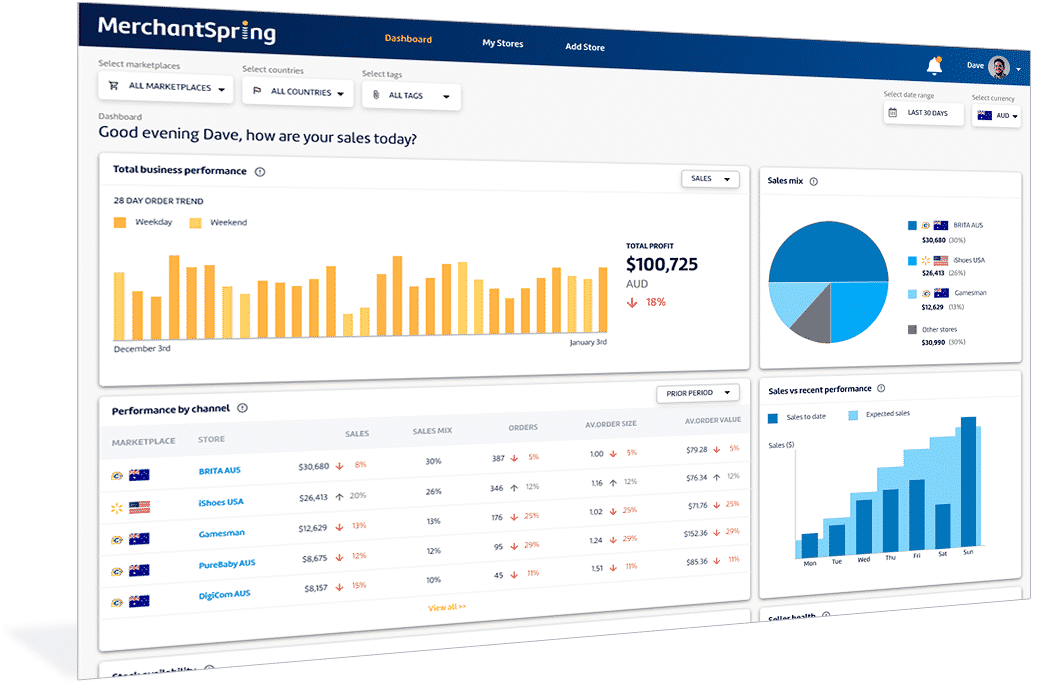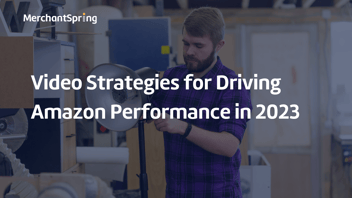Turbocharge Your Amazon Brand Growth with Off‑Amazon Ad Strategies
Overview
If you’re an Amazon agency professional or brand owner, chances are you’ve mastered Amazon PPC and on-platform promotions. But have you tapped into the off-Amazon advertising goldmine? In a recent Marketplace Masters webinar, experts Paul Sonneveld and Sal Conca revealed how driving external traffic to Amazon can be the game-changer that propels your brand to new heights. In this comprehensive guide, we’ll distill their insights into a thought leadership narrative on expanding beyond Amazon’s native tools. You’ll learn why off-Amazon campaigns on channels like Facebook, YouTube, and Google are now essential for Amazon brand growth, how to create content that converts, and how to avoid common pitfalls. By the end, you’ll have a roadmap for an integrated advertising ecosystem that boosts Amazon's performance and builds a resilient omnichannel brand.
“It requires a lot of experimentation and a lot of patience to find the big wins.” — Sal Conca, CEO of Amazing Ads
Why Off‑Amazon Advertising Matters More Than Ever
In today’s competitive marketplace, relying solely on Amazon PPC can limit your growth potential. Off-Amazon advertising – meaning marketing on external platforms to drive visitors to Amazon – is emerging as a must-have strategy for ambitious brands. Why? First, external campaigns can supercharge your Amazon sales rank by delivering bursts of high-intent traffic. Amazon even incentivises this through the Brand Referral Bonus program, which offers sellers an average 10% rebate on sales driven by external sources. Second, off-platform ads allow you to build brand awareness and customer engagement in ways Amazon’s native ads can’t – think rich storytelling via video, interactive social content, and influencer partnerships.
Crucially, off-Amazon efforts help new brands overcome the “cold start” problem. If you launch on Amazon with zero reviews and no recognition, you’ll face sky-high CPCs and stiff competition for on-site ads. As Sal Conca explains, external traffic can jump-start an unknown brand by generating initial sales and reviews, which in turn improve organic ranking. In other words, off-Amazon advertising isn’t just for mature brands that have “tapped out” Amazon’s possibilities – it can be a lifeline for startups trying to gain traction. The key is to approach it as a long-term investment in growth rather than a short-term ROAS play. Brands that embrace an omnichannel Amazon marketing mindset are seeing significant wins in visibility and sales.
One Size Doesn’t Fit All: Crafting a Tailored Strategy
Embarking on external advertising requires a strategic, case-by-case approach. What works for one brand might flop for another. As Sal shares, his agency manages 80+ clients and “they all do it in different ways…marketing just doesn’t seem to be formulaic”. The strategy must align with your brand’s context:
- Pure Amazon Sellers vs. Multichannel Brands: A brand selling only on Amazon might funnel all external traffic to Amazon product listings to maximise rank and Brand Referral bonuses. In contrast, a brand with its own Shopify store has the option to split traffic – perhaps sending prospecting ads to a Shopify landing page (to build an email list or offer a bundle) while still pushing high-intent audiences to Amazon for easy conversion. We’ll discuss more on the Shopify integration shortly.
- Big Budgets vs. Lean Budgets: Larger brands with “deeper pockets” can afford broad experimentation – testing full-funnel marketing across YouTube, Facebook/Instagram, Google Search, Display, and even emerging channels like TikTok. Smaller brands, however, should start with one or two platforms where their target audience is most active. The good news is there’s a viable off-Amazon advertising strategy for brands of all sizes. The common thread is to allocate budget intelligently and track performance closely (more on measurement below).
- Brand Awareness Level: Are you an established name or a newcomer? A well-known brand might focus external ads on brand defense and storytelling – e.g. retargeting past shoppers or highlighting your brand values – while a new brand needs direct-response campaigns to educate the market on its unique value proposition. Every product solves a problem; your external messaging should clearly convey that benefit. As Sal emphasises, “every single product that sells solves a problem for someone…video creative that just lists a bunch of features is not going to get you there”. Tailor your content to make the customer the hero of the story.
Above all, integrated planning is key. Off-Amazon channels should not operate in isolation or feel like disconnected efforts. The most successful brands create an integrated advertising ecosystem where each channel plays a role in the customer journey – for example, a TikTok video piques interest, a YouTube ad educates, a Facebook retargeting ad reminds, and the final purchase happens on Amazon (with Amazon Attribution tracking it all). This holistic approach ensures consistency and maximises the “halo effect” of cross-channel synergy, where the whole is greater than the sum of its parts.
Leveraging the Right Channels: Facebook, Google, YouTube, and Beyond
Which off-Amazon platforms should you use to drive external traffic to Amazon? The short answer: go where your audience spends time. In the webinar, Sal Conca highlighted a few heavy hitters:
- Meta (Facebook/Instagram): Still a powerhouse for targeting consumer interests. Facebook and IG ads offer versatile formats (image, carousel, video) and sophisticated targeting. For Amazon sellers, Facebook is excellent for running promos, contests, or content that sparks initial interest. One pro tip is to use Facebook’s lookalike audiences based on your Amazon customer data (if you have emails from a brand website or past campaigns). Just remember to match the creative to the audience – a one-size-fits-all ad won’t perform as well. For example, Sal audited a brand that was only targeting “Women, 18-65, USA” with generic creative; by segmenting and customising creatives (e.g. different ads for college-age vs. middle-age audiences), you can dramatically improve relevance.
- Google Search and Display: Google Ads can capture high-intent shoppers outside of Amazon. You might bid on keywords related to your product or brand (even your own brand terms – to intercept searchers who go to Google before Amazon). With Amazon Attribution, you can run Google Search or Shopping campaigns and track the sales they generate on Amazon. Performance Max (PMax) campaigns are also a new avenue – Google’s AI-driven ads that span Search, Display, YouTube, Gmail, etc. They can be useful for casting a wide net, but be sure to evaluate if the traffic quality aligns with Amazon conversion (PMax might require fine-tuning).
- YouTube & Connected TV: Sal is “a big proponent of YouTube and connected TV”. Video has an unmatched ability to demonstrate your product and build an emotional connection. Running YouTube ads for Amazon products is a potent upper-funnel tactic: you can showcase how the product solves a problem, feature testimonials or unboxing, and then include a strong call-to-action to visit your Amazon listing.
Custom intent audiences on YouTube allow targeting of users based on Google search behaviour (e.g. target people who recently searched “best gaming headset” with your gaming accessory ad). YouTube ads might not yield immediate conversions like search ads, but they plant seeds that later drive shoppers to search for your brand on Amazon. In fact, one major campaign Sal ran for a gaming brand led to a measurable spike in Amazon brand searches and impressions – clear evidence that off-Amazon video ads lifted Amazon demand. YouTube also provides view metrics (25%, 50%, 100% views) to gauge engagement with your content. - TikTok and Other Social Platforms: TikTok’s explosive growth makes it attractive for certain niches (especially younger demographics). TikTok content tends to be more raw and viral; consider leveraging user-generated content (UGC) style videos or influencers to make ads feel native. While TikTok now offers in-app shopping, many users still see a cool product on TikTok and head to Amazon to find it. Ensure your Amazon listing is optimised and maybe even run a corresponding Amazon Sponsored Brand or Display ad for your brand name – to capture that off-platform interest when it hits Amazon. Other channels, like Pinterest or Reddi,t might be useful if they fit your product category’s community.
- Amazon DSP (Demand-Side Platform): Though technically an Amazon advertising product, DSP often serves ads off Amazon (on third-party sites and apps) to retarget or prospect customers. Sal mentioned layering Amazon DSP on top of other campaigns for a full-funnel approach. For agencies and brands with the budget, Amazon DSP can re-engage those who saw your external ads and later browsed on Amazon but didn’t purchase, closing the loop between off-Amazon awareness and on-Amazon conversion.
In summary, choose channels based on your audience and test aggressively. The first campaign might not hit a home run. But don’t conclude “off-Amazon advertising doesn’t work” from one small test. As Sal puts it:
“Don’t assume because you ran a small test with one video that off-Amazon advertising doesn’t work”.
Instead, iterate on your targeting and creative until you find the winning combo.
Content is King: Creating Video & UGC That Convert
Launching ads on external platforms is one thing – getting people to click and buy is another. Content quality makes all the difference. The webinar drove home several practical content strategies for off-Amazon ads:
- Use Video to Tell Your Story: Video is arguably the most effective content format for external ads in 2025. It grabs attention and can convey a lot quickly. Sal Conca recommends structuring videos using the “Educate” method (attributed to video strategist Tom Breeze): start with a hook that reels in your audience, then educate them on how your product solves a problem, and finish with a compelling call-to-action. For example, in a Father’s Day campaign for a gaming accessory, Sal’s team created a short video showing a dad struggling to keep up with his video-gamer son – until he uses the accessory to level the playing field.
It was entertaining, relatable to the target audience, and highlighted the product’s benefit (making gaming more fun and competitive). User-generated content (UGC) style videos can work great here – real people demonstrating the product or giving testimonials. There are services like Billo (which Sal’s agency uses) where you can get authentic UGC videos made. Make sure the video feels native to the platform (a flashy, polished ad might work on YouTube, but a lo-fi TikTok-style clip could perform better on Instagram Stories or TikTok). - Match Content to Audience (Contextual Advertising): As mentioned, context is everything. Design creatives that speak directly to the interests or pain points of your target segment. If you have distinct customer personas, consider making separate ad variations for each. For instance, an off-Amazon Facebook ad for Amazon listings of a healthy pet treat might have one version targeting “health-nut dog owners” (focusing on natural ingredients and featuring outdoorsy imagery) and another targeting “pet pamperers” (focusing on treat quality and pet happiness). In Sal’s pet brand example, they knew small dogs didn’t like the crunchy treat as much as big dogs, so they segmented creative accordingly. This level of relevancy can dramatically increase engagement and click-through rates.
- Optimise for the Hook and Call-to-Action: When testing creatives, pay attention to two key metrics: watch time (how long people view your video or engage with your ad) and click-through rate (CTR). The opening seconds of a video – or the first lines of ad copy – must grab attention (Stop Scrollers as marketers say). Try different “hooks” that pose a question, highlight a bold benefit, or use an eye-catching visual. If you find one variant holds attention much longer, you’ve likely found a strong hook.
On the flip side, among those who do watch or read, is your CTA compelling them to click? Test different CTAs: “Shop on Amazon Now,” “See it in Action,” “Limited-Time Amazon Deal,” etc. Small tweaks (like emphasising Amazon Prime free shipping or a discount) can lift CTR. Continuous A/B testing is the name of the game – Sal suggests testing 3-5 video creatives at a time, identifying the winner, then iterating with new variations on that winner. - Focus on Benefits, Not Just Features: This age-old marketing advice is worth reiterating. Your off-Amazon ad content should clearly answer the customer’s question: “What’s in it for me?” If you find yourself just listing product specs (e.g. “1080p resolution, 60Hz refresh”), flip the script to emphasise benefits (“Enjoy silky-smooth gaming with no lag on a crystal-clear screen”). As Sal noted, many brands love talking about what they do, but translating features into real-life benefits or pain-point solutions is what converts skeptics into buyers. Off-Amazon ads give you more freedom than an Amazon listing to be creative in messaging, so take advantage of that storytelling space!
“Every product that sells is solving a problem for someone. Storytelling is what makes the customer feel like the hero – a video that just lists features is not going to get you there.” — Sal Conca
By crafting compelling content tailored to your audience and optimising relentlessly, you’ll dramatically increase the odds that your Facebook or YouTube ad actually drives Amazon conversions. Remember, the goal is not just to get views or clicks – it’s to produce real results on Amazon, whether that’s a purchase, a review, or a brand follow. High-quality content is the bridge between external engagement and on-Amazon action.
Budgeting and Attribution: Balancing On-Amazon and Off-Amazon Spend
A common question is how to split your advertising budget between Amazon’s own PPC ads and off-Amazon channels. There’s no universal answer, but here are some guiding principles:
- Evaluate Your Business Stage: If you’re in aggressive growth mode (e.g. a newer brand or launching a new product line), be prepared to invest heavily in awareness and acquisition. That could mean allocating more than 20% of your revenue to advertising for a period of time – a significant portion of which may go off-Amazon to build your brand presence. On the other hand, if you’re an established brand mainly looking to improve ROI, you might keep the majority on Amazon PPC, where conversion rates are highest, and use a smaller portion for strategic off-site campaigns (such as retargeting or product launches).
- Protect Your Amazon Performance: It’s important to maintain a baseline of on-Amazon advertising (Sponsored Products, etc.) to keep your listings competitive in search. Off-Amazon ads should augment, not replace, your Amazon PPC. A smart approach is to treat Amazon PPC as your conversion engine and external ads as the fuel feeding more people into that engine. In fact, external ads can indirectly improve your Amazon PPC efficiency by boosting sales velocity and organic rank (leading to better ad placement and lower ACoS). Amazon’s algorithm rewards listings that drive external traffic with improved ranking, creating a virtuous cycle.
- Leverage Amazon Attribution for Data: One of the biggest challenges (and criticisms) of off-Amazon advertising is attribution – how do you know if your Facebook ad led to an Amazon sale? Fortunately, tools have improved. The Amazon Attribution program provides special tracking links (and an API) to measure purchases that came via external ads. By generating an Amazon Attribution tag for each campaign (or even each ad creative), you can track conversions and sales amount in Amazon’s attribution dashboard. This data is gold for calculating the true ROAS of your off-Amazon ads and justifying your budget. Additionally, Amazon Attribution links enroll sales in the Brand Referral Bonus, giving you that ~10% referral fee credit – effectively improving your off-site ad ROI. Make sure you set up Attribution for Google and Facebook campaigns, and use Amazon’s Brand Referral Bonus links for influencer or email traffic.
- Track Leading Indicators: Not every external campaign will show an immediate profitable ROAS in attribution reports. Especially for upper-funnel efforts like YouTube or display ads, you should also monitor indirect metrics. Sal mentions watching brand lift – e.g. increases in Amazon-searches for your brand/products, and overall page views – during and after big campaigns. These indicate that people who saw your ads are taking action later (possibly organically). Amazon’s Brand Analytics or business reports can show you trends in impressions and branded search volume. A spike there, correlated with your campaign timing, validates that your off-site ads are working even if the last click wasn’t directly tracked.
- Iterate on Budget Allocation: Over time, use data to adjust your mix. If Amazon Attribution shows your Google Ads are delivering a $5 ROAS while Facebook only $2, you might shift some budget from Facebook to Google, unless Facebook is crucial for generating awareness that later converts via other channels. Always pair the quantitative data with a qualitative understanding of the customer journey. For instance, you may find many customers first saw a Facebook video, but later searched on Amazon to buy – so the Facebook ad assisted the conversion. In marketing, this is known as multi-touch attribution, and while Amazon’s tools are limited to last-click, you can infer assists by surveying customers or analysing time-lag patterns. The bottom line is to budget holistically. Some dollars will be for immediate ROI, others for future payoff. Set expectations accordingly with your team or client.
One more note: Don’t be afraid to invest in off-Amazon advertising early if growth is your goal. As Paul Sonneveld observed, many sellers assume external ads are only the next step after maxing out Amazon ads. In reality, starting off-Amazon ads sooner can accelerate your Amazon success – it’s like adding an extra engine to your growth machine. Just ensure you have a way to measure and iterate, as described above.
Boosting Results with Shopify and Buy With Prime Integration
Many Amazon-focused businesses debate whether to even run a DTC site like Shopify alongside their Amazon presence. The webinar provided a clear perspective: operating a Shopify store in tandem with Amazon can enhance your off-Amazon advertising effectiveness – if used wisely.
Here’s how a Shopify site (or any direct-to-consumer site) can play a role:
- Better Tracking and Customer Data: When you drive traffic to your own website, you can pixel and track users with much more detail (Facebook Pixel, Google Analytics, etc.) than when sending traffic straight to Amazon. You also gain the opportunity to capture customer emails, set cookies for retargeting, and build lookalike audiences. As Sal noted, conversion tracking is much easier on your own site than on Amazon’s pages. If you’re running substantial ad campaigns, being able to analyse on-site behaviour (bounce rates, add-to-cart rates, etc.) can help you optimise your creatives and landing pages for better results.
- Buy With Prime – Best of Both Worlds: In 2022-2023, Amazon rolled out the Buy with Prime program, allowing sellers to offer Prime checkout and fulfillment on their DTC site. This is a game-changer. By installing the Buy with Prime button on your Shopify, you let visitors enjoy the same fast Prime shipping and trust factor, while you retain the customer data and relationship. Even more importantly for ads, Buy with Prime orders are trackable – you can attribute them to your ad campaigns and see conversion data, which historically was impossible when sending traffic to Amazon (since Amazon kept the checkout data).
Sal was initially skeptical Amazon would share this data, but indeed, with Buy with Prime “they’re not gatekeeping the customer – you know the buyer’s info and you can see the conversion”. For example, if you run a Facebook ad to your Shopify landing page featuring a Prime checkout, you’ll see the purchase in your Facebook Ads Manager conversion metrics, plus the sale still counts toward your Amazon sales velocity (inventory is fulfilled from FBA). It’s truly having your cake and eating it too. - Merchandising Strategy – When to send to Amazon vs. DTC: Not every product should be sold on every channel, and smart brands use merchandising to complement their advertising. A common tactic is to list your entry-level or single-unit products on Amazon (to leverage Prime’s logistics for cheap items) while using your Shopify to sell bundles, multi-packs, or higher-margin offerings that make more sense for direct shipping. For instance, one brand selling barbecue sauces and rubs found it unprofitable to ship one $10 bottle via their own site (shipping costs would kill margin), so they direct those single-bottle sales to Amazon FBA.
Meanwhile, on their Shopify, they feature gift box bundles and subscription packs that increase the average order value, which can absorb shipping costs or use Buy with Prime for fulfillment. Your off-Amazon ads can be routed accordingly: a Google ad for “buy BBQ sauce” could send to Amazon (where a Prime member can easily buy one bottle), whereas a Facebook ad for “ultimate BBQ gift set” might land on Shopify, where a deluxe bundle is offered. Integrating your channel strategy this way maximises profitability and customer satisfaction. - Long-Term Brand Building: Having a DTC site alongside Amazon gives your brand resilience and more marketing avenues. You can build an email list of customers who buy on Shopify, then use email marketing to drive repeat purchases on either channel. You can pixel your site visitors and retarget them with ads that send them to Amazon later (some customers will prefer buying through Amazon, even if they first learned about you on your site – that’s fine, you want the sale wherever they’re comfortable). Essentially, a Shopify site can act as a marketing hub: a place to publish content, run referral programs, collaborate with influencers (who can send traffic to your site with their affiliate links or codes), and more – all while Amazon handles the fulfillment via Buy with Prime if you choose. It’s a powerful combination when done right.
Of course, running a Shopify store isn’t trivial – it’s an extra channel to maintain. But the panel’s advice is that it can be well worth it for the attribution clarity and customer data alone. If you do go this route, ensure you set up Buy with Prime to avoid channel conflict, and be thoughtful about which ads/link go to which destination (Amazon or Shopify) based on the strategy. When in doubt, test both and see which yields higher total sales. The end goal is to make it seamless for customers to buy your product wherever they prefer, while you harvest the data and keep your logistics efficient.
Common Pitfalls to Avoid (Learn from Others’ Mistakes)
While off-Amazon advertising offers a huge upside, it’s not without pitfalls. Here are the top mistakes that Amazon agencies and brands should steer clear of, according to our experts:
- Lack of Strategy or Consistency: Don’t dabble aimlessly. One of the biggest errors is approaching external ads without a clear game plan – for example, sporadically posting on social media or running a couple of unfocused ads and then declaring it “didn’t work.” Off-Amazon advertising requires a strategic plan and consistent execution. Sal observes that many brands try a half-hearted campaign and give up too soon, instead of analysing and refining the approach. Treat it with the same rigour you would an Amazon PPC strategy: define your target audiences, craft tailored messages, set budgets, and run tests for a significant period (weeks or months) to gather data.
- Poor Creative Briefs & Execution: Another mistake is underestimating the creative challenge. External ads must earn the audience’s attention; they aren’t like Amazon Sponsored Products that appear when someone is already searching to buy. If you don’t have in-house expertise in video/content creation, consider partnering with specialists or creators. Using platforms like Billo or working with freelance UGC creators can help – but even then, you need a strong creative brief. Sal warns that unless you’re skilled at articulating your brand narrative and value props to creators, the resulting content might miss the mark. Avoid generic, feature-only ads or ones that look too salesy. Also, refresh creatives regularly – ad fatigue is real, and what worked last quarter might need a new twist now.
- “All Eggs in One Basket” Syndrome: It’s risky to rely on just one channel (including just Amazon itself). If you only run Amazon PPC and nothing else, you’re vulnerable to rising CPC costs and algorithm changes. Conversely, if you put your entire external budget into, say, only Facebook ads, you could be in trouble if that channel’s performance dips. The ideal is a balanced portfolio of channels. Sal describes lighting up multiple channels in parallel to create a halo effect – “one channel is going to feed another, and you now have an omni-channel presence”. For example, your Google Ads can capture interest generated by your TikTok videos, and your email campaign can follow up on traffic from your YouTube ad. This synergy not only improves overall results but also insulates you from one channel tanking. Diversify your traffic sources just as you would diversify investments.
- Ignoring Amazon Groundwork: While focusing on off-site ads, don’t neglect the fundamentals on Amazon itself. If an external ad succeeds in driving a click to your Amazon listing, but then the shopper encounters a poor product detail page (bad photos, sparse description, few reviews, uncompetitive price), you’ve wasted your effort. Optimise your Amazon listings for conversion – high-quality images and A+ Content, clear benefit-driven copy (consistency with your ad messaging is a plus), and a competitive price/value. Also, ensure your inventory is in stock; nothing’s worse than paying for a visitor only for them to see “Currently unavailable.” Off-Amazon ads will amplify whatever state your Amazon listing is in – so make sure it’s retail-ready to convert the new traffic.
By avoiding these missteps and following the best practices we’ve outlined, you can dramatically tilt the odds of success in your favour. Off-Amazon advertising isn’t a magic bullet – it’s a skill to be developed. Start small, stay strategic, and learn from each campaign.
Conclusion: Expand Your Reach and Own Your Growth
In the evolving world of Amazon commerce, the brands and agencies that win are those who look beyond Amazon’s walls and build a presence wherever their customers spend time. Off-Amazon advertising allows you to turbocharge your growth by tapping into new audiences and creating a cohesive brand journey from discovery to purchase. It’s about being proactive – not waiting for shoppers to find you, but actively reaching out across social media, search engines, video platforms, and the open web to bring them into your funnel.
The insights from Paul Sonneveld and Sal Conca make one thing clear: off-Amazon marketing is no longer optional for ambitious Amazon sellers – it’s an integral part of a holistic strategy. From harnessing engaging video content and user-generated content ads that resonate, to leveraging tools like Amazon Attribution and Buy with Prime for seamless tracking and conversion, the opportunity is huge. Yes, it requires investment, creativity, and thoughtful planning, but the payoff can be a brand that not only excels on Amazon but has its own thriving omnichannel ecosystem.
Ready to put these ideas into action? Start by picking one off-Amazon channel and planning a pilot campaign. Apply the tips you’ve learned: define a goal (e.g. increase Amazon sales by X%), identify your target audience segment, craft a killer piece of content for them, and launch with tracking in place. Monitor results, adjust, and then expand to additional channels as you find what works. Over time, you’ll build a robust marketing machine that drives sustained Amazon growth.
Sal Conca (CEO of Amazing Ads) and Paul Sonneveld discussed these strategies in depth during the webinar. To hear all the examples and pro tips straight from the source, watch the full webinar replay here. If you’re keen to elevate your Amazon analytics and attribution game, don’t hesitate to reach out to us at MerchantSpring – our platform is designed to help Amazon agencies integrate and streamline multi-channel data. We’re here to support your journey to off-Amazon advertising success.
Unlock your brand’s full potential by embracing an off-Amazon strategy. Watch the on-demand webinar for a deeper dive, and contact MerchantSpring for a personalised demo on how our analytics platform can empower your agency with unified Amazon and external campaign insights. Let’s supercharge your Amazon growth together!


-Aug-15-2025-01-51-29-2918-AM.png)





.png?width=352&name=logistics%20in%20north%20america%20(1).png)





Add a Comment